In February 1945, 78 years ago, the Allies had finally broken through “The Bulge” and pushed back a massive German counterattack. Many American soldiers had hoped the war might be over by Christmas. But Hitler’s last desperate gamble took Allied troops (and their commanders) by surprise. Almost 20,000 American lives were lost, and 50,000 injured. Ultimately Allied land and air forces took back the German gains and by February, were moving rapidly toward Berlin. One of those soldiers who survived, miraculously uninjured, was medic Ed McCarrick. The following is from a 1989 recording of Ed and his recollections of that terrible time,…JS
If you’re a regular Zephyr reader, you’ve probably heard the name “Ed McCarrick.” Ed was a ranger at Arches National Park in the 70s and 80s and became one of the original “Arch Hunters.” (I’m in the process of rewriting that piece with many more photos).

Ed and I EOD’d (“Entered On Duty” in Park Service jargon) on the same day— April 11, 1976. I was 23. Ed was 57. We were the rookies at Arches and both grossly underpaid and happy as hell to be there. Ed was the GS-3 Ranger who ran the entrance station. I got the better deal duty-wise; I was also a lowly GS-3 but I worked and lived at the Devils Garden Campground at the end of the 18 mile park road. I lived in the tin trailer at the campground entrance that everyone thought must have been Ed Abbey’s
But the following year, Ed and I were both promoted to GS-4 (wow) and Ed got out of the entrance station and became a park interpreter–he led Fiery Furnace Walks, gave campfire talks and worked the desk. That same year, a retired NASA engineer named Reuben Scolnik showed up, looking for Arches,and we all became familiar with Texan Doug Travers, who had been visiting the park and looking for arches for a decade before we arrived. Our boss, Chief Ranger Jerry Epperson assigned us the “task” of searching the backcountry for more arches. We all took the job to heart, but Ed surpassed us all in his eagerness to find every rock opening in the park.
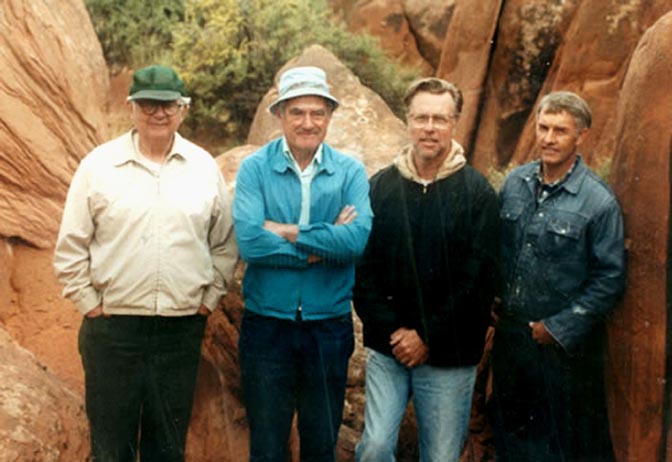
All this is in the Arch Hunters story, and if you want to know more, you can click the hot link or wait for the new version. This story has absolutely nothing to do with Arches or Moab or the National Park Service. It’s about World War II, the Battle of the Bulge, and Seventh Battalion Medic Ed McCarrick…as told by Ed.
One hot summer day, as we wandered the Devils Garden, I asked Ed about his life before Arches. I knew that he and his wife Claire had lived in New Jersey for most of their lives and had only moved to Moab in the early 70s. His accent sort of gave his place of origin away. Ed’s distinctive and irreverent radio voice made for great entertainment. He was always worried that I didn’t have a girlfriend and he’d actually call me on the park radio, which could be heard by every park service employee in 50 miles and say something like, “Hey Jim, there’s somebody headed your way in a brown Pinto. Texas plates..she’s a real tomato.”
Nowadays, he’d be fired and shot. But being shot (or to be precise, shot at) would not have been anything new for Ed. It occurred to me that he had been the ripe age to serve in the Second World War. My dad was just a couple years younger and had been the navigator of a B-24 Liberator in the Pacific. So one day I asked Ed if he’d been in the military during the war?
Ed stared at me a second. “Yes…I was,” he said quietly. “I’m lucky to be alive. And I hated that damn Patton. What a jackass..all the enlisted men hated him.”
“You weren’t at the Battle of the Bulge were you?” I asked. He nodded grimly.
Before he started to tell the story, I stopped him. “Wait Ed,” I said. “This is an incredible story; would you let me record you? When we get home, let’s set up a time and I’ll let you tell the story from beginning to end. And this will give you some time to collect your memories.”
He thought for a moment. Almost hesitant. But finally he nodded and said, “Sure. “Let’s do it. But I can tell you this…I don’t need to ‘collect my thoughts.’ There are some things you never forget” I had known Ed McCarrick for over a decade, but until this moment, like so many other young men of his generation, he had never mentioned the war, or his time in it. And as it turned out, he had been in the real thick of it.
It took a few weeks to arrange a good time but finally, in December 1989, I met up with Ed at my place. We sat down on the couch, turned on the tape recorder and just let him tell the story. Coincidentally, we did this interview on the 45th anniversary of the Battle of the Bulge….
Here is WWII through the eyes of Ed McCarrick…
December 7, 1941
“I was in a store in Newark, N.J. buying candy when the news of Pearl Harbor came across on the radio. I was already registered for the draft. I’d done it the previous July and so I knew I was going to be in the Army. I decided I’d rather get in the Marines. I probably liked the uniform or something. I was a kid.
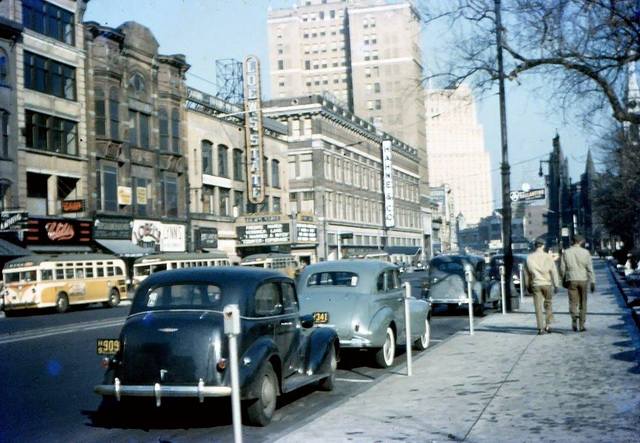
“But my draft board wouldn’t release me because they had to meet their quota. Maybe they did me a favor; if I’d been in the Marines, I might’ve been knocked off at Guadalcanal. Who knows?
“So on February 10, 1942, I was in the Army. First I went to Camp Dix and then to Camp Polk, Louisiana. I had basic training with the Third Armored Division. After Basic we were getting different assignments and they were putting us in lines. The other lines had hundreds of men in them, and one line had about five. We thought maybe they were just going to ship us home. But it turned out to be a medical detachment. I had no background in it, but they decided to make me a medic. They sent us to a reconnaissance battalion, and as soon as we heard that, we thought, ‘that’s it—that’s a suicide battalion.’ We figured we didn’t have a chance.
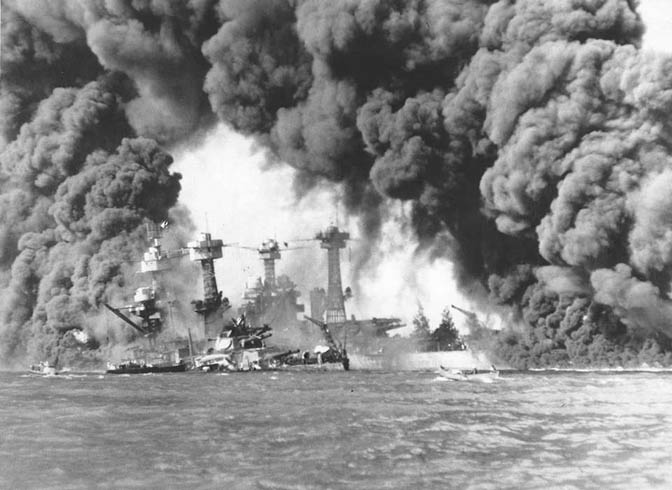
“We stayed at Camp Polk for 13 months, and then went to the California desert for desert training for 5 months. We went there because of the fighting in Africa, but when that ended, they sent us back to Ft. Benning, Georgia. It was interesting meeting different guys from different parts of the country, but we were all doing the same thing, eating the same food. When we went to town, it was different– you’d go to a restaurant, and in New Jersey, you’d never see fried chicken or hushpuppies or stuff like that.
“From there we went to Camp Myles Standish in Massachusetts, which was an embarkation place. That was the most chickenshit outfit I ever saw in the Army because they made us walk in formation to go to chow. But usually you stayed there for four or five days and then got on a ship; but we stayed two weeks, and we wondered: ‘What the Hell is going on?’ The Army is screwed up as usual. I’d finally gotten a pass to go to Boston, but when I hit the gate, they said our outfit’s been alerted. You’ve got to go back.
“They stuck us on trains and shipped us to Camp Shanks, New York. At Camp Shanks, nobody stayed more than 3 or 4 days, but we were there for a month. So again we all complained that the Army was screwed up as usual.”
June 6, 1944
“Finally, we got on the Queen Mary in New York Harbor. It was June 6, 1944–D-Day. The Normandy Invasion. It turned out the reason our departure had been delayed was because the invasion had been delayed. The original plan called for an invasion date in early May, but the weather was really bad and they had to cancel. For the invasion to work, everything had to be right. Not just the weather, but also the phase of the moon, and the tides. The invasion had to come at low tide early in the morning. So the truth was, there was actually no room over there on the British Isles to put us, until the invasion began and our soldiers started moving onto French soil. So really, the Army wasn’t as screwed up as we thought.
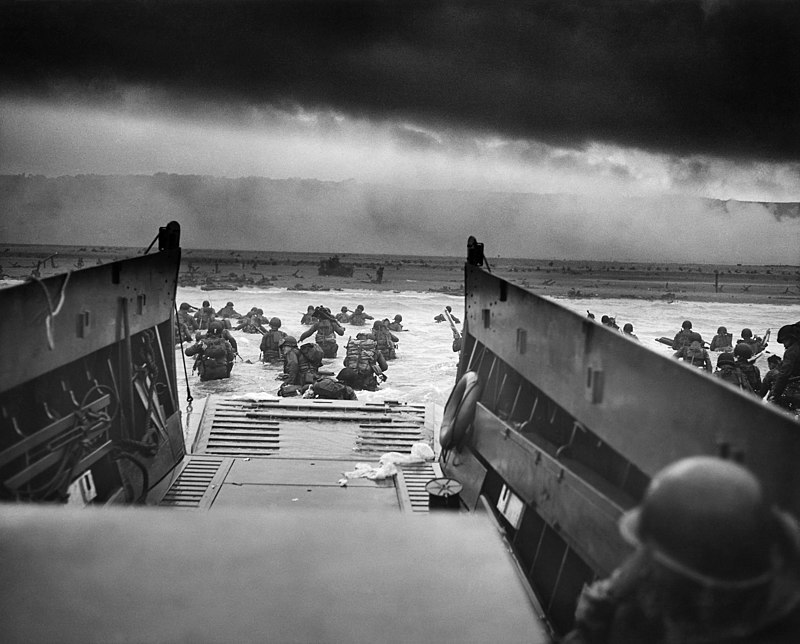
“Anyway there were about 15,000 of us on the Queen Mary. I was in a cabin made for two with about eight guys in there. It took six days, which really wasn’t too bad; we could outrun any German submarine. We got to England and stayed at a place called Tidworth Barracks, which was near Andover and Salisbury.
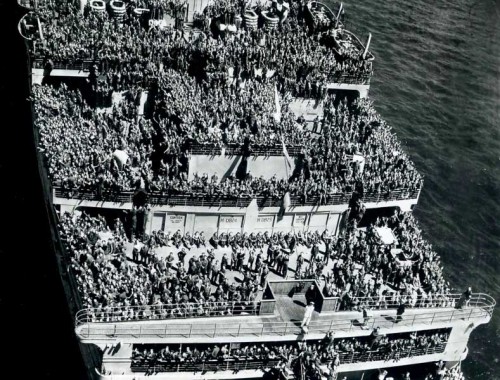
“Meanwhile hedgerow fighting was going on in France, and none of us wanted to be a part of that crap, although we didn’t have much choice about it. We were in England less than a month when they took us down to South Hampton and put us on the L.S.T.s (landing ship tank) and that was when they made the breakthrough out of the hedgerows at St. Lo and we got off the boat and exploited it. We landed there on the Normandy Beaches where the invasion had taken place. We were to follow the breakthrough.”
Patton and the 7th Army
“When we got to France, we became a part of Patton’s Army, the 7th unfortunately. We knew that. When we were in England, he came and gave us a speech. I never heard anybody talk in front of 10 or 15 thousand guys like he did. Every other word was a curse word. Of course in the Army we all talked like that, but not in front of ten thousand guys. Most of us thought it was disgusting even if we said the same stuff. He was explaining the incident in North Africa when he got relieved of his command for hitting a soldier that had combat exhaustion. He said there was no such thing as combat exhaustion. All you had to do was be tough on them, and they’d come out of it. Next Sunday, the chaplain mentioned the atrocious language of a certain general; later at medic school the doctors explained that in spite of what a certain general said, there really was such a thing as combat exhaustion.
“Anyway we started moving fast across France. There was no front at all really because we were moving so fast. Usually, we’d hear there were some Germans in a town, and we’d go in and blast the heck out of them and they’d take off. The next day we’d do the same thing. At one point we went 700 miles in 21 days, which was unheard of in combat. In fact, in the fall of ’44, we thought the war would be over by Christmas. We were knocking the hell out of these guys.
“But the first thing that slowed down was we ran out of gas. We were moving so fast that we outran our supply lines. It gave the Germans time to recoup.

“It was in Chartres where I finally got close to the action–bombs going off, one of the towers of the cathedral got hit. Right after that we were supposed to take Metz, which is right on the French-German border. A corps reconnaissance outfit had gone in and thought it was clear, but the Germans were watching. We thought it’d be easy to take. But instead we got blasted with everything. For some reason I wasn’t with the line troop, I was with HQ Co. about three miles back. My captain, a doctor, got killed there.”
Eyeball to Eyeball with General Patton
“This is where I saw Patton. We were stopped in this convoy, and I was in a half-track. I saw these three vehicles come down and as they got closer I saw the two stars–it’s got to be Patton I thought. Patton climbs out and yells, ‘Where’s an officer?’
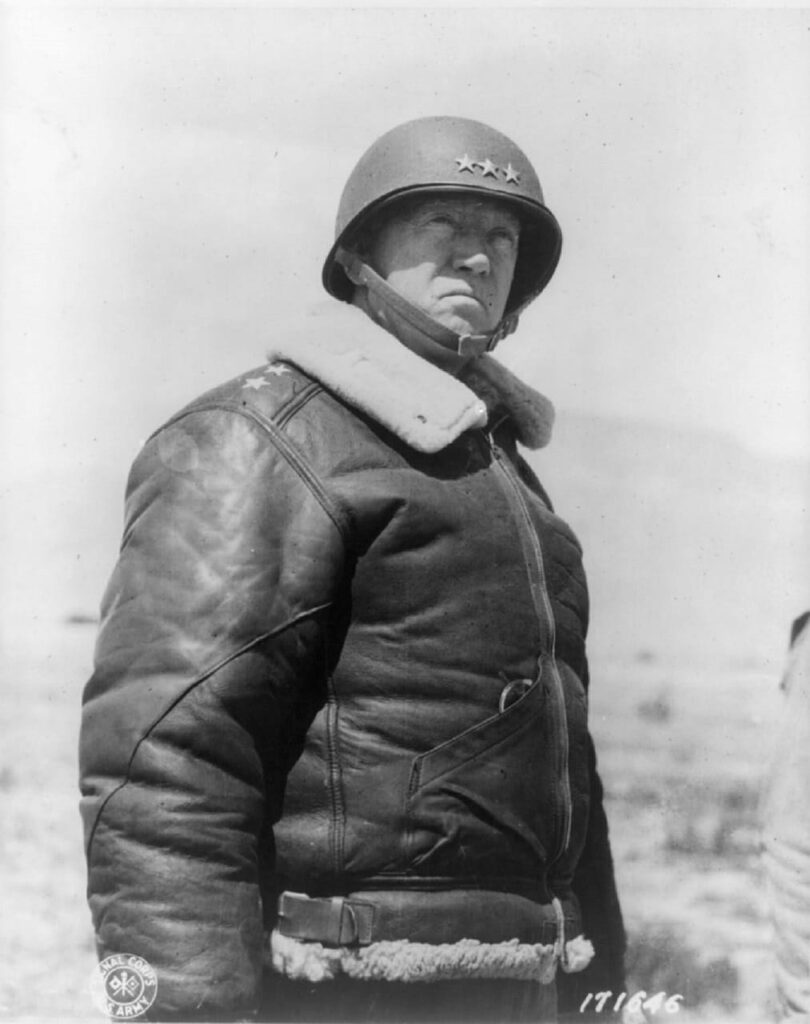
“Meantime, this French vehicle comes flying down the road, and Patton yells, ‘Stop that vehicle!’ The Frenchman gets out and makes a real snappy salute, and Patton smiles and says, ‘Bon.’ If he hadn’t saluted Patton like that, he would’ve been chewed out.
“By this time, somebody found an officer, Captain Newton, and Patton yells, ‘What outfit is this?’ The captain responded, ’87th Reconnaissance 7th Army Division, sir.’ Patton says, ‘If this is reconnaissance, why the Hell aren’t they at the front?’ After a few more questions he says, ‘Where’s the communications vehicle?’
“I was in the next vehicle back, and I ducked down because I didn’t want him yelling at me. Besides, I was a lowly PFC. So he goes back to the vehicle and yells, ‘If there isn’t some audacity shown around here, some officers are going to be busted!’
“He went back to his Jeep, and which way did he go? He turned around and went back the other way. The next day in Stars and Stripes, big headlines read “PATTON VISITS TROOPS AT FRONT.” This is the kind of publicity crap that went on about Patton. Hell, he was five miles from the front! He was such a glory hound. Anyway that was my major encounter with General Patton, that jerk. My captain got killed at the front and Patton got the glory, five miles away.”
A Medic on the Front Lines
“Back to when we were trying to take Metz, I remember the 5th Infantry Division was assigned to take the town and we all knew it was going to be a slaughter. The Germans controlled this hill and you had to go up it to attack. There were guys crying because they knew they were going to be killed. Eventually, we went around Metz.
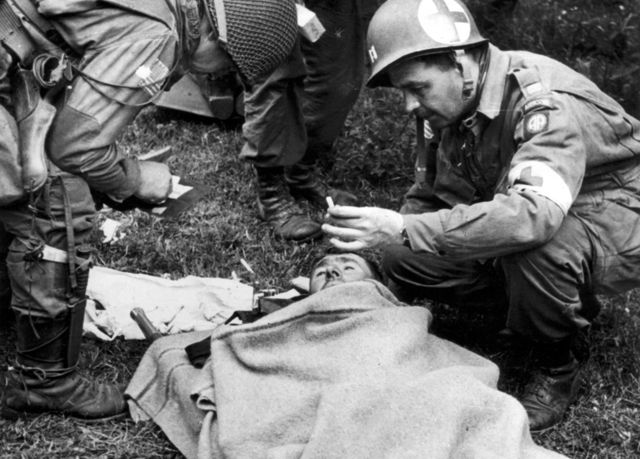
“As a medic in Troop C, we went in to get the injured. It was interesting to note that we never went in there under fire. We had the Red Cross on our helmets of course, and the Germans wouldn’t shoot us. There were times when I went out and I knew the Germans could see me, but they left me alone. In that case, they were observing the rules of warfare. Of course, they had medics too. It was pretty rough seeing guys hurt and killed, sometimes guys you knew. But, of course, it wasn’t as rough as the guys being hurt and killed.
“Later, we moved into Holland, and we got word that Germans were infiltrating the lines, disguised as American soldiers. This one guy got shot, and the brass wanted us to go out and get the body to prove that it was an infiltrator. They told this staff sergeant named Richie Gibson (he was also from Newark) to take a couple guys out and get the guy tonight. They decided they needed a medic along, so they picked me. We left that night and we were way out there in No Man’s Land, beyond the last American outpost. They told me to stay by this empty house while they went in. I was there by myself and, oh boy, I started getting lonesome.
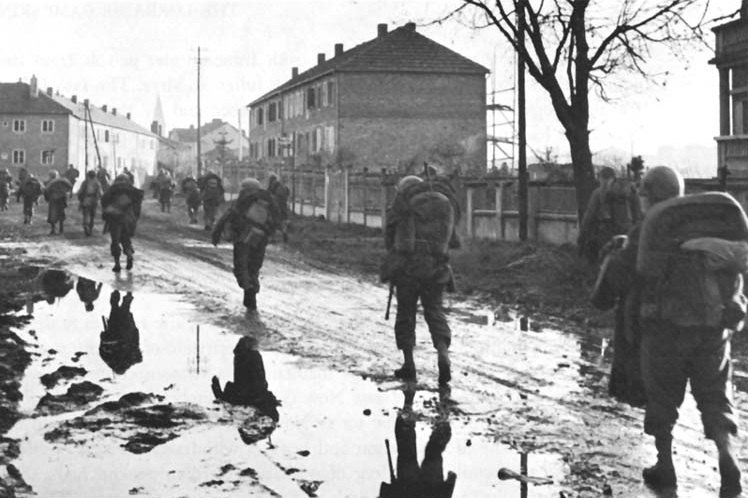
“Meanwhile I could hear all this traffic, all these motors going, and what I was hearing was the Germans. I thought, I wish those guys would get back. I want to get the Hell out of here.
“Finally my buddies came back with the body, and he was dressed in an American uniform, but under it was a German uniform. And we thought he had probably just put the uniform on to stay warm. We took the body to a Colonel Dempsey of Division, and he looked at him and said: ‘Hmm. Hmm. He’s no spy; he was just staying warm.’ That was that. They risked four lives to bring back a dead guy, and then that was that.”
The Bulge
“The next morning the Germans came across a canal, invaded the place, we got pushed back, and all those motors I’d heard during the night were the attack force. It was also this attack that caused me to lose my jeep and all my possessions. I’d decided to clean it out and everything was out of it when the Germans attacked. I had souvenirs and pictures and I lost all of it. But I forgot all about that at the time. Guys were getting hurt–Gibson the sergeant with whom I went to recover the body, got shot in the face and lost his eye. But we held on, only a couple of companies really, and later we got the Presidential Citation.
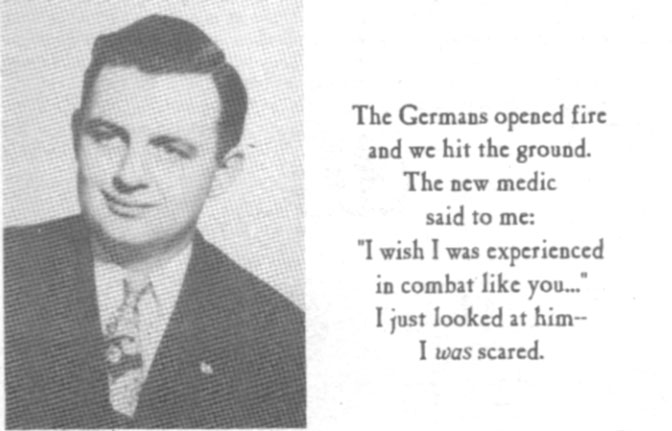
“After that, they told us we were going to have some time to rest, to clean out the jeeps, take showers and all that. That night at 7 p.m. we found out we were moving out; we were going south to set up a secondary line of defense. We drove all night in a convoy, lights off, and arrived at this town in Belgium. The Germans had made a minor breakthrough.
“My captain told me to go out and find C Troop and take this new guy with me. We went way out this road and we came to a T in the road. One way said ‘Malmedy,’ the other ‘St. Vith.’ Which way? We turned left and went a couple of miles and we didn’t see anything. I said, ‘I don’t like this, something’s screwy,’ and decided to turn around. Finally, I found a guy and he gave us directions, but we were way out there, and I figured the Germans must have been watching me run up and down that road, with the Red Cross on the vehicle. We were miles ahead of the front.
“The next day things were a mess. There were vehicles going every which way. The Germans opened fire and we all hit the ground. The new medic said to me: ‘I wish I was experienced in combat like you.’ I just looked at him–I was scared.”
Holding St. Vith
“Finally, we got directions to C Troop which was supposed to be at St. Vith. Of course, we had no idea where that was. But it turned out, it was right in the middle of the German offensive that we later called The Bulge. St. Vith had a highway and was a major railroad center. The Germans thought if they could take St. Vith, they could drive all the way to the ocean and split the Allied Armies in two.
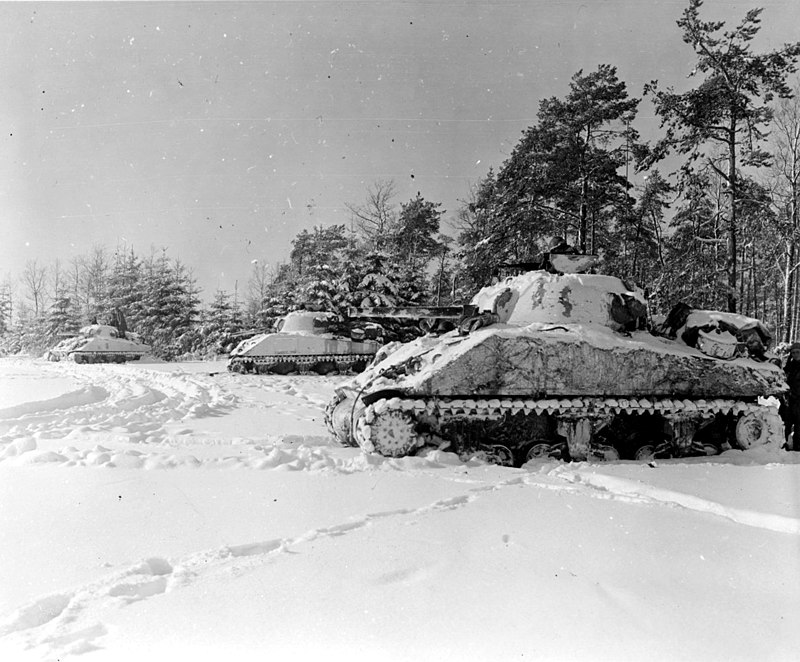
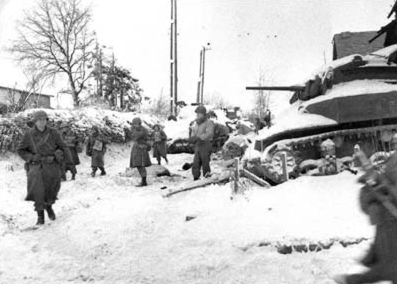
“I got back to C Troop at St. Vith; we were on one side of the town and the Germans on the other. All day long, we’d attack them and then they’d attack us. The next day it was quiet. I wandered out and found an abandoned American vehicle with all these uniform clothes. They fit me perfectly. Anyway when the Germans attacked, they had concentrated on the 106th Division. This was full of never-tested soldiers and the Germans must have known that. The 106th just broke and ran, and abandoned all that stuff. We even found frozen steak and french fries. I remember I’d cooked all this stuff up and was ready to eat, when they yelled ‘Gotta move out! Germans are breaking through!’ So I took the stuff with me. I figured, damn if they catch me, I’m at least going to have a full stomach.
“We held St. Vith for six days. For most of the time, I thought this was it–that I’d either be killed or captured. Things were really getting bad, we’d been cut off, and we had this captain that we called G.I. Johnson, because he was so much by the book. Anyway, he was on the radio saying, ‘We’ll fight to the last man!’ and I felt like hitting him over the head with something. I figured, why doesn’t he just stay here himself and fight and get the rest of the guys outta here. But we finally pushed the Germans back again, so we didn’t have to fight to the last man.
“We started moving through St. Vith, and they had these checkpoints, looking for Germans disguised as Americans. They’d ask us questions like, who won the World Series, to test us. There was a doctor with us, an American but of German descent, and he was scared of his own shadow. Anyway, here’s this guy being questioned, and he speaks with a German accent. Well they pulled him off the truck and said, ‘You’re coming with us.’ The guy must have died a thousand deaths.
“Because we had defended St. Vith, we got another Presidential Citation. After The Bulge, the Germans were defeated… they were worn out. Within four months the war was over and I was back home by September 1945. It was the hardest time of my life. I never realized how much I loved home and my family and America until I was away from them. Some things we should never take for granted.”
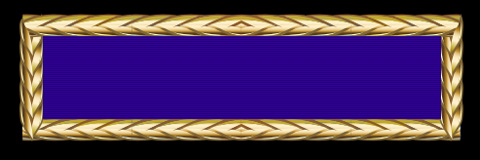
POSTSCRIPT:
Ed returned to New Jersey and eventually went to work for Western Electric as an accountant in Newark. It was there that he met his future wife, Claire Melesky. He retired after 34 years and soon after, he and Claire moved to Moab in the early 1970s. A year later, his daily life could not have been more different. From accountant to arch hunter in the relative blink of an eye. Eventually, Ed and yet another of the original arch hunters, Dale Stevens, compiled a book of all the known arches in the park. I believe it is still for sale at the visitor center.
Ed’s health declined suddenly in late 1991 and he died of cancer on March 22, 1992. Just a month earlier he was honored by the Arch & Natural Bridge Society for his tireless efforts in search of arches. Ed McCarrick was only 72 when he passed away. Way too young to leave us. But if you could ask him now, he’d tell you in his distinctive Jersey accent, “I should’ve lived longer, but at least I outlasted that SOB Patton.”
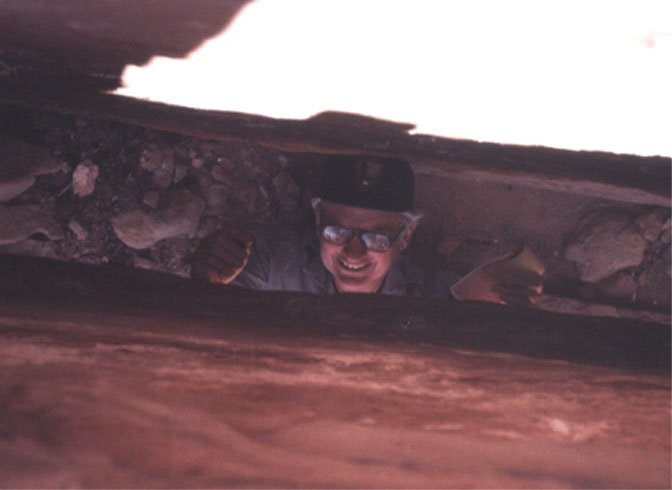
(or ‘rock opening’ as some of us described them)
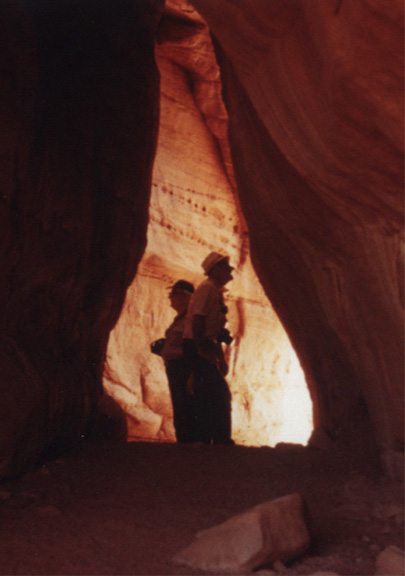

Jim Stiles is the founding publisher and editor of The Zephyr. To contact Jim, you can find him on Facebook or email him at: cczephyr@gmail.com
(“Clinging Hopelessly to the Past Since 1989”)
TO COMMENT ON ED McCARRICK’S AMAZING STORY, PLEASE SCROLL TO THE BOTTOM OF THIS PAGE

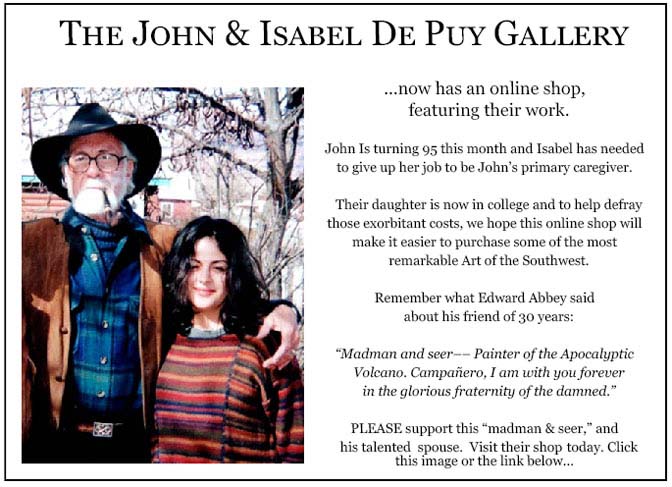
Thanks to them, our bills were almost completely covered.
Now I’d like to return the favor. Check out the link below and their online shop… JS
https://www.depuygallery.com/shop.html
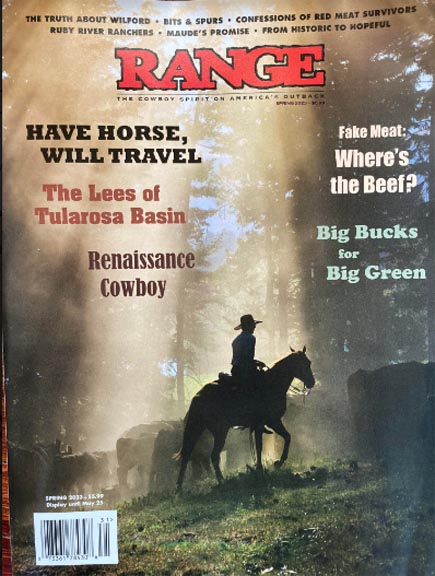
https://rangemagazine.com/subscribe/index.htm

Why they can’t just leave the site alone is beyond me, but that’s what Facebook likes to do.
ALSO NOTE: I post old photographs and stories from our 25 year old archives every day. Pictures from Herb Ringer, Edna Fridley, Charles Kreischer.. even a few old photos from my Dad. So if you want to stay caught up on our amazing historic photo collections,
be sure to “follow” us on Facebook…Thanks…Jim
https://www.facebook.com/FansoftheCanyonCountryZephyr/
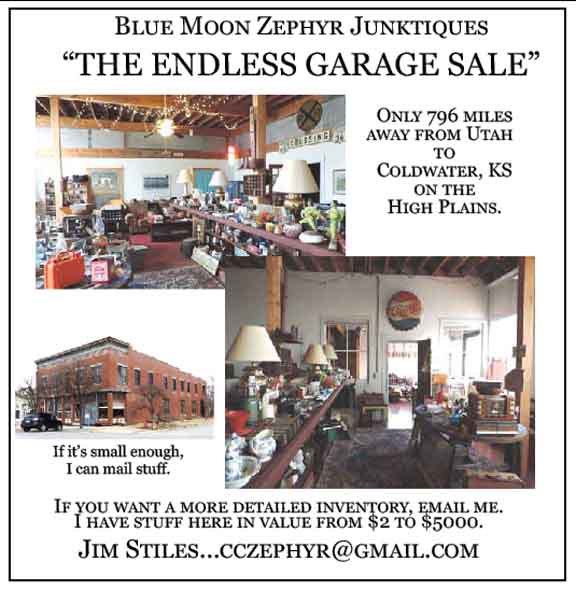
cczephyr@gmail.com


NOTE: The story below, about the terrible events of July 4, 1961, has been read by almost 20,000 Zephyr readers. I am hoping that new information from the U.S. National Archives may be forthcoming in the next few weeks. Hopefully they will shed even more light on this enduring tragic mystery….
Please take the time to read it and follow the links to the original story — they are very long and detailed narratives, so choose a time when you can devote your full attention to them…
Thanks, Jim
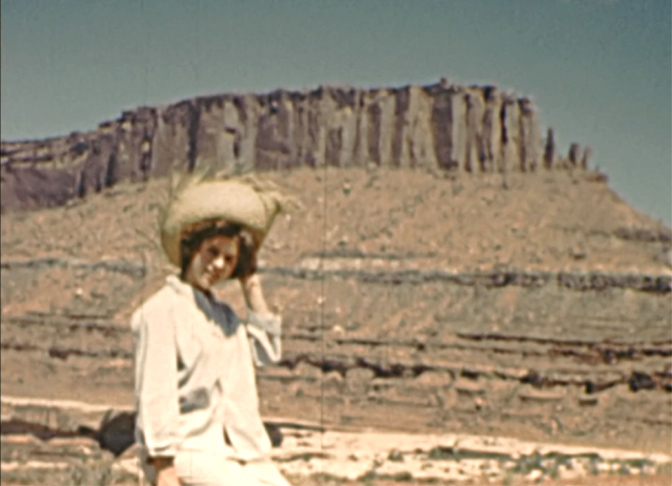
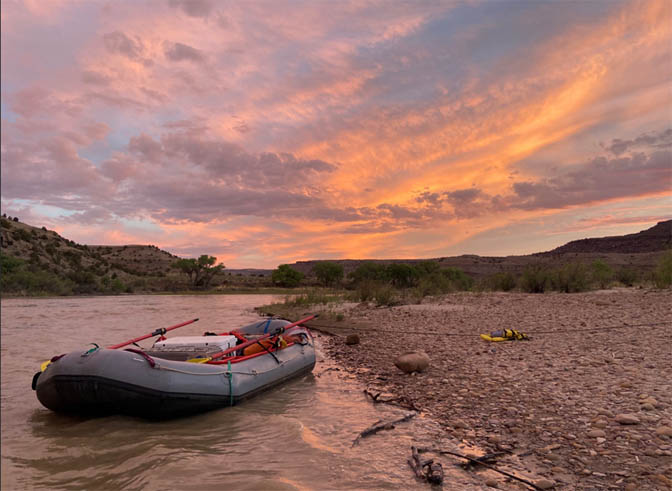
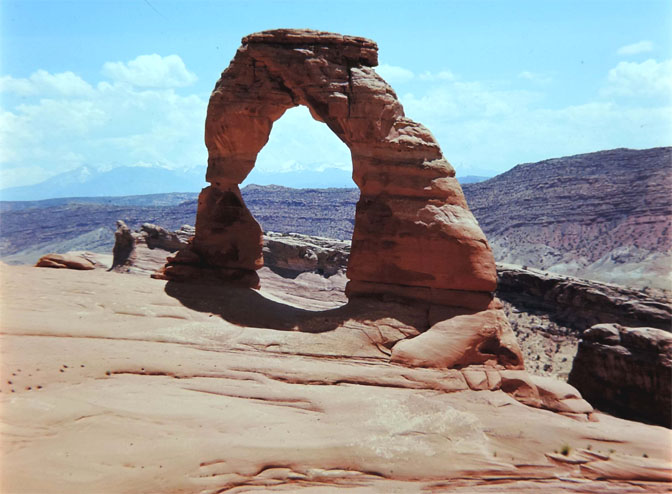
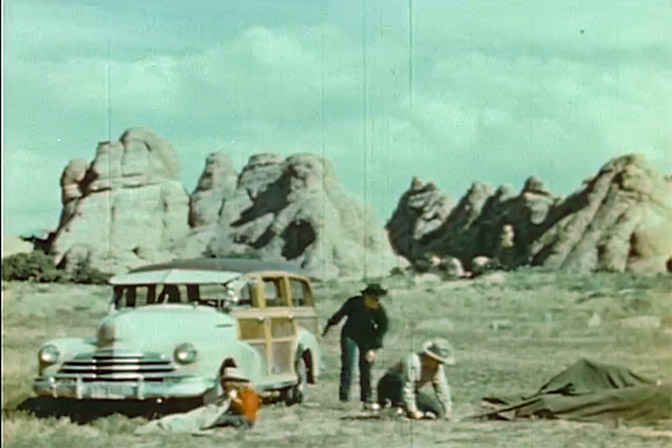
https://www.canyoncountryzephyr.com/2023/01/01/unsung-videographers-of-canyon-country-1949-ray-virginia-garner-zx43/
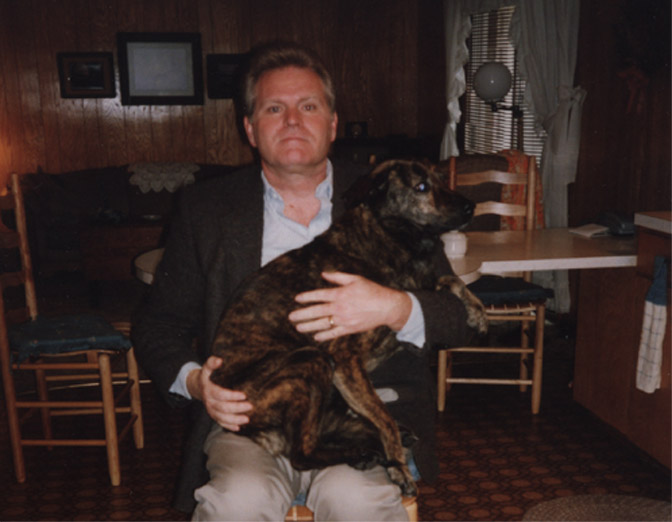
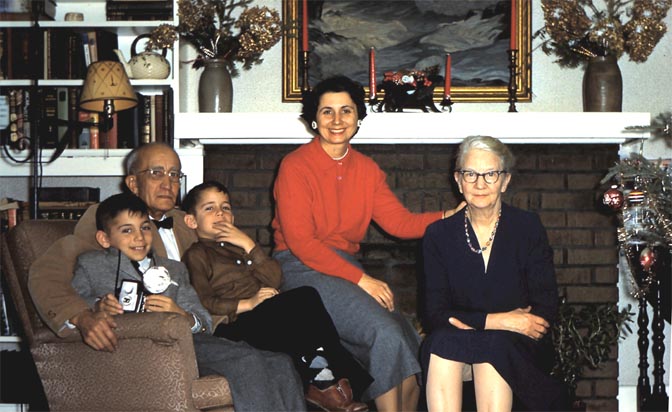
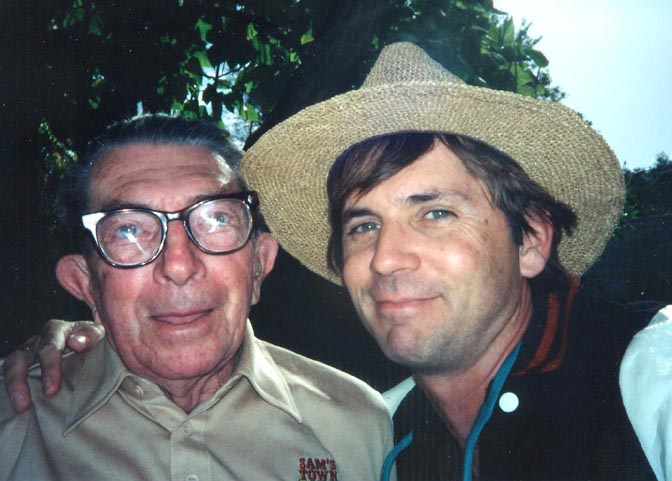
https://www.canyoncountryzephyr.com/2022/12/11/i-longed-for-the-western-life-herb-ringers-great-adventure-jim-stiles-zx39/






It is hoped that stories like Ed’s will give your readers a look at reality about war! World War II veterans are dying every day and those stories shouldn’t be forgotten. Youngsters fresh out of school were put in positions they’d never imagined and they fought with courage, fiercely and many lost their lives.
How fortunate that you thoughtfully recorded Ed’s story!! And despite the awfulness of war, I’m sure those days of hunting for “Holes” were most fulfilling for him. Terrific story! Donna Andress
Great interview and story Jim. Ed really left his mark.
I went hiking with Ed a couple of times when I worked at Arches. He was always fun to be around. I wish I’d known that he’d been with Patton. He and my Dad could have had some chats about Patton since my Dad was also in The Battle of the Bulge. They may have crossed paths.
I remember that when I was a kid, almost every adult male had been in the Armed Services, but few of them talked about it. I was 30 before I knew that Dad had been at D-Day plus 3. It was a couple of years later that I found out he’d been in the Bulge.
Thank you for writing this eye witness account of the famous battle of the Bulge in WWII. He was a hero. The greatest generation. True account of the horrors of war. My dad had a congenital heart defect and worked as an engineer at an oll refinery to support the troops. He died age 58. All my uncles were soldiers in WWII, one was an OSS behind enemy lines. As your article says, they went on with their lives and didn’t talk about the horror, but suffered the memories in silence. Another important historical article.
I certainly enjoyed reading about his experiences. My father shared this experience as he was drafted out of college, became an infantry rifleman and fought with the 9th infantry division from The Bulge to Berlin where the war ended. Like so many, Dad made very few references to his war experiences. I picked up bits and pieces from quick, short stories he might tell when with his brother or in laws that were also veterans. He never gave me a chronology of his actions. I believe the war was traumatizing for many participants and they down played it in their minds. I remember him once referring to incoming German artillery, “88 rounds caused the trees to explode, it was very…..very bad.” Those were his reflections. This makes what you shared all the more valuable and important. Thanks.
Hey Jim
It’s just great to read your story about Ed McCarrick and to hear his story. I sure remember his disdain of Patton. Ed was such a cool guy. Just my dad’s age. We carpooled to work sometimes with his little VW and stopping to buy the little 6 oz frozen cans of lime juice! Our very little son loved to kick around the 6 oz orange juice cans I’d drop to the floor after rinsing them out. Back when toys weren’t all plastic and costly!
thanks for the good reminders, Jim.
I went to Tower arch with the Travers family and received the pass- what a crazy idea- they couldn’t count an arch until they’d made a successful pass with the football they always carried!
Thank you very much, I am glad I did not miss this. Ed had a great way with words – nothing extra needed. Gayemarie
There were many who returned home after World War II too stunned or wounded to talk about their experiences, yet Ed tells his story of that dreadful time with great candor and clarity. He led an astonishing life and you have documented this account beautifully. Despite the high number of American casualties, the Battle of the Bulge crippled the German Army. McBeth Scharf, the brother of Margaret Oviatt for those who remember the Oviatt family, was killed in the Battle of the Bulge on January 13, 1945. He is buried in the old Moab cemetery.